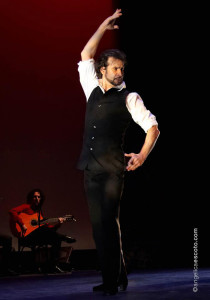
Renowned Kathak Master Pandit Chitresh Das is not new to collaborations. His partnership with tap virtuoso, Jason Samuels Smith, has been touring continuously since 2005 to critical acclaim across the globe and is the subject of the award-winning documentary film, Upaj. When asked about his current collaboration with Flamenco artist Antonio Hidalgo Paz he said, “I am passionate about collaborations because they enable me to maintain the integrity of the Kathak tradition, while simultaneously expanding the spectrum of the art form. Collaborations enable me to challenge my own, and ultimately the audience’s, pre-conceived notions of these traditions. Antonio is a mature and adventurous artist with tremendous depth and virtuosity. I was inspired by how open and adventurous he was in approaching our work together.”
Hidalgo Paz has been equally inspired within the collaboration with Pandit Das and writes, “Working with an artist the caliber of Das, the aura he has, the speed he works in and the rhythmic concepts and sounds of the music he creates, has taken me to my artistic limit; it has taken me to a new dimension because flamenco’s rhythms, while complicated, are much more predictable. Working with Das is like working without a safety net.”
The two artists first met at American Dance Festival in 2004 where they performed in the Festival of the Feet, a program that highlighted the similarities between tap, Kathak and Flamenco. At first glance it is clear that Flamenco and Kathak have much in common; they both employ improvisation, similar lyrical upper body movements and percussive footwork. With an obvious difference being that the Kathak artist dances barefoot and wears heavy ankle bells while the Flamenco dancer wears shoes. Live music and complex rhythmic cycles are central components to both art forms. In Flamenco, guitar, singing, clapping and a drum accompany the dancer. In Kathak, the musical accompaniments often include sitar, tabla, sarangi and vocals. In addition, both Flamenco and Kathak have Indian and Muslim cultural and religious influences. While there is controversy about whether Flamenco has its roots in Kathak, the shared elements of the two forms are undeniable.
The roots of Kathak go back thousands of years.and in medieval times the kathakas were the internet (storytellers), wandering the countryside informing and entertaining through dance, music, mime and poetry. Somewhere along this journey these dancing storytellers ended up in the deserts of Rajasthan.

This is where the story of Yatra begins, with the sunrise in the Rajastani desert. While choreographing the first scene of Yatra Das warned, “You have to be ready for anything, like the warriors of the desert.”
Kathak seems like a natural pairing with flamenco and indeed Pandit Das has worked with flamenco artists in the past. In the 1980’s he performed with Rosa Montoya whom he met at San Francisco State University where he established the first university accredited Kathak course in the US. In January of 2013 Das and Hidalgo Paz toured four cities in India, but their new work entitled, Yatra: Journey from India to Spain will be a world premiere. In addition to a fine musical cast featuring Indian classical musicians Debashis Sarkar (vocal, harmonium), Jayanta Banerjee (sitar) and Satiya Prakash (tabla) performing alongside flamenco percussionist and singer Francisco Orozco “Yiyi” and a flamenco guitarist this new endeavor will also feature multi-media to enhance the visual as well as visceral journey the audience members will embark upon along with the artists.
Das first began using fi lm to enhance his productions in 2001 when he began working with photojournalist and videographer Ajoy Roy for his biographical solo Sadhana. His most recent creation, Shiva, used film to create the aura of the Himalayan Mountains. In Yatra, film will be used to transport the audience from the deserts of India to the courtyards and courts of Alhambra, Spain.
Yatra will prove to be not just the journey of a dance, but an artist’s trajectory. Das will be 70 years in November and is still at his peak as an artist. Brought to the US in the early 1970s on a Whitney Fellowship to teach Kathak at the University of Maryland, Das has since established the largest Kathak training academy in North America, Chhandam School of Kathak Dance with branches in the San Francisco Bay Area, Los Angeles, Mumbai, Kolkata and Boston. Recognized by the Obama administration in 2009 with NEA National Heritage Fellowship Das has tirelessly followed his mission to educate and promote Kathak. Splitting his time between the US and India has proved challenging, especially since the recent birth of his two daughters, who ironically were respectively born on August 15th, India’s Independence and July 4th, America’s Independence.
Growing up in Calcutta before India’s Independence his parents ran a dance and cultural institution that attracted some of India’s greatest Gurus, intellectuals, artists and innovators like Uday Shankar and Rukmini Devi. Das’ father created one of the first revolutionary dance dramas in Kolkata. Like his parents, Das has been inspired since childhood to push the boundaries of his art form and connect with others, creating and innovating within tradition. Das first had the spark for the idea of Yatra at age 14 after seeing the movie Around the World in 80 Days. He decided he wanted to work with the great flamenco artist Jose Greco. Das has found his Greco in Hidalgo Paz. Das’ internal journey has led him down many paths, but always the ones less traveled. Expect Yatra to be nothing like anything you’ve seen before.
Yatra: Journey from India to Spain will perform at The Palace of Fine Arts September 27-28. More information at kathak.org.
This article appeared in the September 2014 issue of In Dance.


